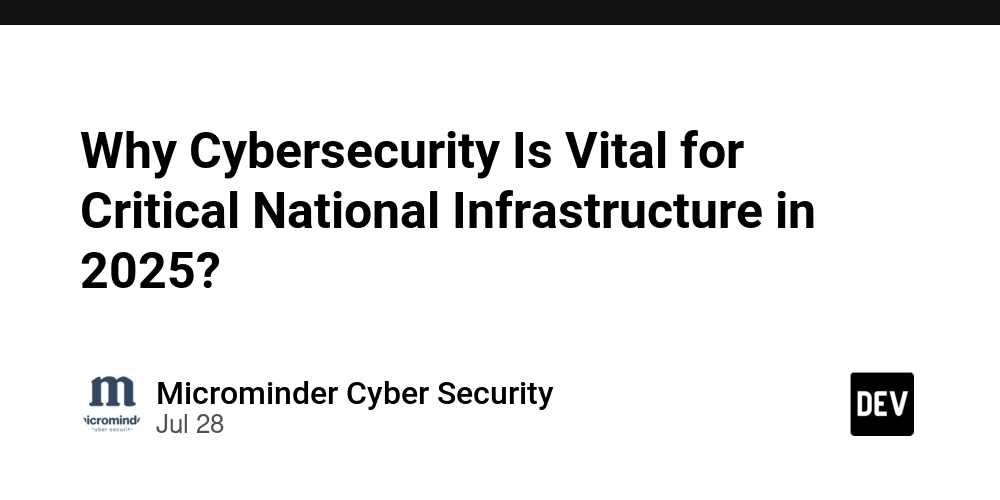Why Cybersecurity Is Vital for Critical National Infrastructure in 2025?
In 2025, Critical National Infrastructure (CNI) — the backbone of a nation’s security, economy, and public health — faces an unprecedented wave of cyber threats. From energy grids and water systems to transportation, healthcare, and finance, CNI sectors have become primary targets for both state-sponsored hackers and sophisticated cybercriminals.
Cybersecurity for CNI is no longer just a recommendation; it’s a national imperative. Here’s why.
What Is Critical National Infrastructure (CNI)?
Critical National Infrastructure refers to the essential systems and assets that are vital to the functioning of a country. These typically include:
-
Energy (power plants, oil & gas pipelines)
-
Water & Waste Management
-
Healthcare Systems
-
Finance & Banking
-
Transport & Logistics
-
Telecommunications
-
Defense & Government Services
The failure or disruption of any of these sectors due to a cyberattack could result in massive economic damage, public safety issues, and national instability.
Why Is Cybersecurity Critical for CNI in 2025?
1. CNI is more digitized and interconnected than ever
Thanks to the widespread integration of IoT, SCADA, cloud platforms, and AI-based automation, CNI systems are more efficient but also more vulnerable. Many legacy OT (Operational Technology) environments, originally designed for isolated operations, are now connected to IT networks and the internet, exposing them to threats they were never meant to handle.
🔍 Example: In the energy sector, remote monitoring systems increase efficiency but also expand the attack surface.
2. Rising Nation-State and Ransomware Threats
Geopolitical tensions in 2025 have escalated the use of cyberattacks as a tool of hybrid warfare. According to Microminder Cyber Security, over 60% of attacks targeting CNI in the Middle East in 2024 were linked to state-sponsored actors, especially those aiming to disrupt energy and water sectors.
Simultaneously, ransomware groups are exploiting CNI with “double extortion” techniques, demanding millions in ransom while threatening public exposure.
Case in point: In early 2025, a major transportation authority in Europe faced a two-week disruption due to a ransomware attack on its signaling system.
3. Cyberattacks on CNI Can Cost Lives
Unlike data breaches in e-commerce or SaaS, a cyberattack on a hospital or energy grid can result in immediate harm to human life. In 2023, the U.S. Cybersecurity and Infrastructure Security Agency (CISA) confirmed that a ransomware attack on a hospital led to delayed surgeries and patient relocations. The consequences in 2025, with more systems connected, could be far worse.
Example: A malware incident in a Middle Eastern water treatment facility led to unsafe chemical levels, nearly contaminating public water supply.
4. Regulatory Pressures and Compliance Standards Are Tighter
Nations are implementing stricter cybersecurity mandates in 2025 to safeguard CNI. Examples include:
Organizations managing critical infrastructure now face hefty penalties for non-compliance and mandatory breach disclosures. Cybersecurity is not just an IT responsibility — it’s a board-level concern.
5. AI-Driven Attacks Are Emerging
In 2025, threat actors are weaponizing AI and deep learning to conduct more evasive and autonomous cyberattacks on infrastructure. For instance:
-
AI-enhanced malware that adapts in real time to bypass detection.
-
Deepfake voice attacks mimicking engineers to manipulate control systems.
-
LLM-based phishing campaigns tailored for OT engineers.
Cybersecurity for CNI must now include AI-powered defenses such as anomaly detection, automated response, and threat hunting capabilities.
6. Legacy OT Systems Remain Vulnerable
Many industrial systems in CNI sectors still run on outdated operating systems like Windows XP or proprietary software that hasn’t seen patches in years. These “insecure by design” systems cannot be easily upgraded or replaced without disrupting operations — making them ideal targets for attackers.
Legacy risks are compounded when insecure protocols like Modbus, DNP3, or OPC-UA are left unprotected.
What Can Be Done? Cybersecurity Best Practices for CNI
To build cyber resilience in 2025, organizations must:
-
Segment IT and OT Networks – Use firewalls, unidirectional gateways, and DMZs.
-
Implement Zero Trust Architecture – Never trust, always verify – especially in remote access to control systems.
-
Run Regular Penetration Testing and Red Team Exercises – Especially on ICS, SCADA, and PLC environments.
-
Adopt Threat Intelligence & SIEM Tools – For proactive monitoring and faster incident response.
-
Invest in Workforce Training – Most attacks still begin with human error. Regular training reduces phishing success rates.
-
Comply with Industry Standards – NIST, ISO 27001, ISA/IEC 62443, and local government regulations.
Final Thoughts
As we move deeper into the digital age, the cybersecurity of Critical National Infrastructure in 2025 is directly tied to national survival and public safety. The stakes are no longer theoretical. A well-executed cyberattack can blackout cities, contaminate water, paralyze hospitals, or crash financial systems.
CNI organizations must move from reactive to proactive cybersecurity — integrating advanced defenses, regular assessments, and cross-sector coordination.

